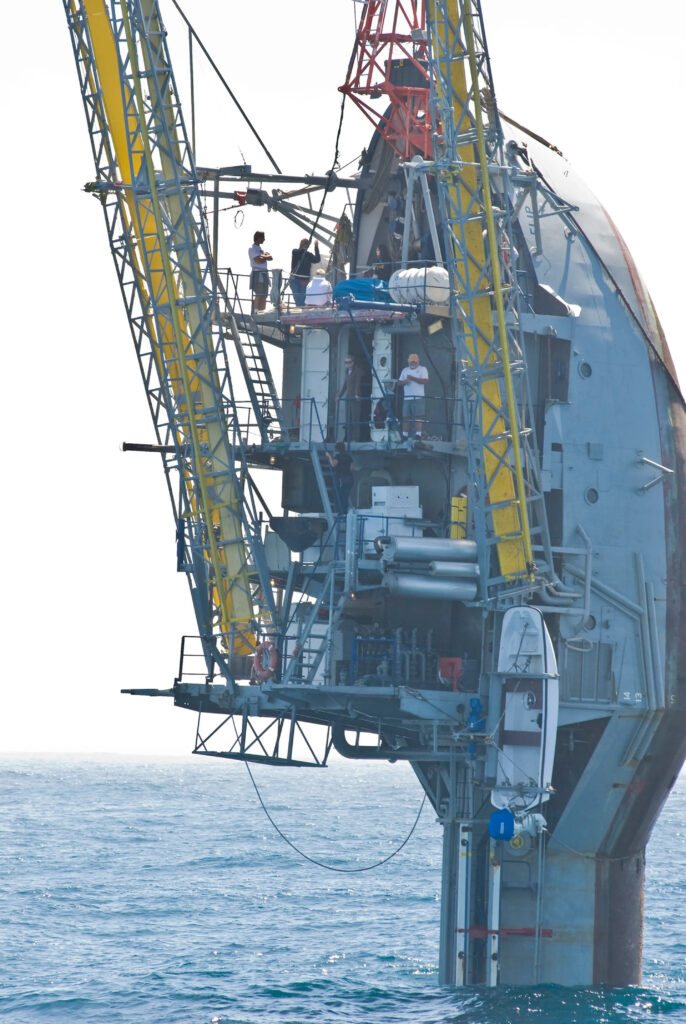Peter Lobner, updated 30 October 2024
The UUM-44 SUBROC (SUBmarine-launched anti-submarine ROCket) was a 22 ft (6.7 m) long, inertially-guided, long-range weapon that consisted of a solid fuel booster rocket with a W55 thermonuclear depth charge warhead.

Udvar-Hazy Center. Source: National Air & Space Museum
As shown in the following diagram, SUBROC was launched horizontally from a standard submarine 21 in (533 mm) diameter torpedo tube. When the missile surfaced, the booster rocket ignited and flew toward the target. The warhead separated when the booster was expended and then flew a ballistic trajectory to the target area, where it re-entered the water and detonated at a prescribed depth.


The SUBROC had a range reported in various sources from 25 – 50 miles (40.2 – 80.5 km), roughly bracketing the range from the launching submarine to a deep water target in the first convergence zone. This deep water acoustic phenomena focuses sound from a distant target at specific distances (convergence zones), depending on a variety of hydrographic conditions, and can permit passive detection of a surface or submerged target at much longer ranges than are possible by a direct path.
Development by Goodyear Aerospace began in 1958, technical evaluation was completed in 1963, and Initial Operating Capability (IOC) aboard USS Permit (SSN-594) was achieved in 1964.

While SUBROC production ended in 1968, the weapon was operational for 25 years, until it was retired from the U.S. submarine fleet in 1989. The National War Memorial Registry preserves a record of a Cold War memorial plaque commemorating the SUBROC at the corner of C Street & 1st Street in Norfolk, VA.

So what’s the connection between SUBROC and the unique 355-foot (108-meter), non-self-propelled vessel known as the FLoating Instrument Platform (FLIP), which was designed with a rather conventional bow and a long cylindrical hull that could be partially flooded at sea to enable the vessel to float vertically in the water with most of the hull submerged, like a giant spar buoy?

Scripps Institute of Oceanography provides the following answer:
“Research Platform FLIP was developed to provide a stable platform to measure fine-scale fluctuations in phase and amplitude of sound waves for the U.S. Navy SUBROC (SUBmarine ROCket) program. One of the major questions concerned bearing accuracy obtained acoustically out to convergence-zone ranges. Horizontal temperature/salinity gradients in the ocean could introduce bearing errors in the volume of the ocean, and sloping bottoms could do the same for acoustic paths that interacted with the bottom. The Navy needed precise measurements to determine the effect of environmental gradients and fluctuations.
On July 23, 1962, FLIP was tested for the first time in the Dabob Bay area of the Hood Canal in Washington state on the Navy tracking range. After successfully completing trials of the flipping operation, it was towed to San Diego to commence operations in September 1962.
Many years of operations have included deployments in the Pacific as far as Hawaii and one deployment to the Atlantic. While originally intended for acoustic research, it has become a versatile platform for research in upper-ocean physical oceanography, meteorology, geophysics, and biology.”
FLIP’s bow contained the uniquely-equipped habitable spaces that enabled the crew and scientists to work when the ship aligned horizontally or vertically.



Source: Scripps Institute of Oceanography
After an operational lifetime of more than 60 years, during which FLIP conducted more than 380 flipping operations, the unique vessel was retired and towed to a dismantling and recycling facility in Mexico in August 2023.
30 October 2024 update:
Fortunately, FLIP has been saved by the UK firm DEEP, which announced in October 2024, “..the rescued platform has made its way from Mexico, through the Panama Canal and across the Atlantic to the Mediterranean, where over the next 12 – 18 months she will be refitted and modernized in France.” You’ll find more information on DEEP’s acquisition of FLIP in the 23 October 2024 DEEP press release and the related USNI article.
For more information on SUBROC and FLIP, check out the following references:
- David Szondy, “Remembering FLIP, the US Navy’s self-sinking research ship,” New Atlas, 12 July 2024: https://newatlas.com/military/when-us-navy-flipped-flip-transformer-science-vessel/
- “FLIP, History,” Scripps Institute of Oceanography: https://scripps.ucsd.edu/ships/flip/history
- “Goodyear UUM-44 Subroc,” Directory of U.S. Military Rockets and Missiles, 19 July 2002: http://www.designation-systems.net/dusrm/m-44
- “UUM-44 SUBROC Nuclear Missile,” flickr: https://www.flickr.com/photos/rocbolt/albums/72157631456257716/
- “Sonar Propagation,” ES310 – Introduction to Naval Weapons Engineering, , FAS Military Analysis Network, 20 January 1998: https://man.fas.org/dod-101/navy/docs/es310/SNR_PROP/snr_prop.htm
- “Sound in the Ocean,” Naval Gazing, 22 May 2022: https://www.navalgazing.net/Sound-in-the-Ocean
Thanks to Lyncean member Dick Traci for sending me a link to the David Szondy article.